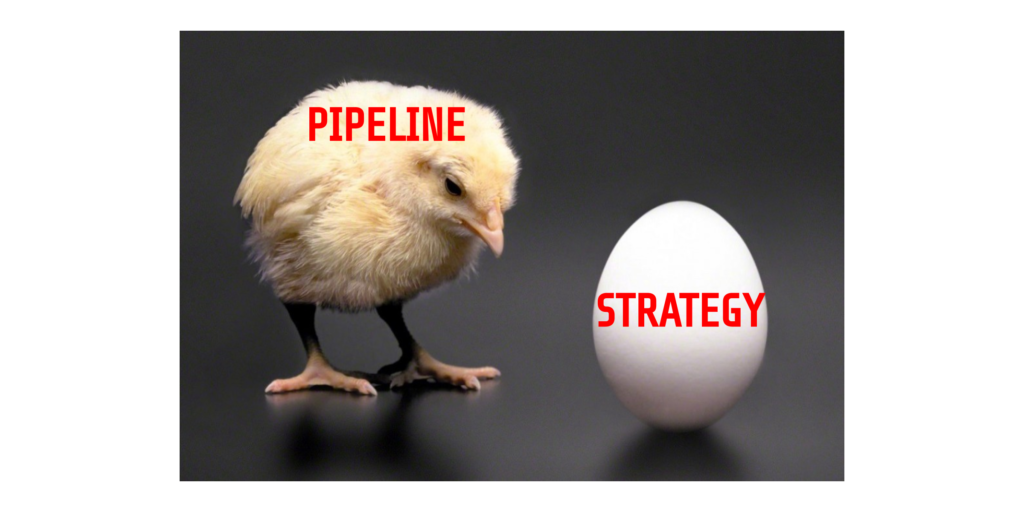I’ve seen this dilemma play out in many different shapes and forms with owners of software companies in the past 18 months. Naturally, I tried to understand where this comes from.
Unfortunately, I am not sure I can say where it comes from and why it happens.
But I can write how I would answer if I were in their position.
The question is: can you work on your strategy if you don’t have a consistent, healthy sales pipeline?
For companies selling software services, what is the more important challenge to solve first? Pipeline or strategy?

It seems a lot of people believe that you first need to have a consistent pipeline of leads and opportunities before you can even start thinking about a strategy.
I am convinced that the opposite statement is true.
Strategy comes first and it’s the starting point for all go-to-market efforts, to have a chance of building that healthy pipeline.
When do you know you have a healthy sales pipeline?
There are several ways to look at this.
The first one is practical and very quick.
Answer this: In the past 3 months, did you say NO to a project 1 minute before signing the contract?
This is my personal definition of a healthy pipeline for a software services company.
It happens when you move a project opportunity through all possible stages, you negotiate the contract with the potential customers, you have all the paperwork prepared. But you stop the process, because you don’t have enough capacity in the team or you cannot create new capacity in due time for that project.
If you don’t have that many opportunities in your pipeline and you cannot afford to say no to a client like that, your pipeline’s health could probably be improved.
Pipeline Coverage Ratio
This second approach is also practical, it just takes longer to reach a conclusion.
It involves doing one basic calculation based on your pipeline metrics.
Pipeline Coverage Ratio = Total Pipeline Size / Sales Target
To determine if you’re in a good position or not, you need to take into account your win rate.
If your average win rate is around 25%, you need a Pipeline Coverage Ratio of at least 4 to have a chance of reaching your sales targets.
The higher your win rate, the lower the ratio needs to be, and vice versa.
In practice, a Pipeline Coverage Ratio between 3 and 5 is considered good.
Sales Pipeline Velocity
This is also practical, but it takes even longer to calculate the first time you try it.
Sales Pipeline Velocity = No. of deals * Average deal size * Win rate percentage / No. of days in the sales cycle.
Once you have a number, for example that you are currently generating 3.000 EUR/day from your current pipeline, you have to compare it with your revenue targets.
The result of this comparison is going to tell you how healthy your pipeline really is.
Depending on your context, you might want to use weeks or even months instead of days in the formula.
Cocktail glass, not a funnel
If you want to go the visual route, instead of the mathematical one, we can also do that.
We are conditioned to see our sales pipelines as a funnel, with opportunities dropping off at a constant rate at all possible stages: prospecting, discovery, demo, proposal, negotiation and so on.
If your pipeline is a funnel, it’s not good.
A healthy sales pipeline looks like a cocktail glass. The biggest number of opportunities are lost after the first stages, through a good qualification process.
In a healthy pipeline, any deal that goes past discovery would have a very high probability of reaching the signed contract state.
What I’ve learned
After many mistakes that I’ve made and many missed sales forecasts over the years, I’ve learned to:
- Assign a value only to project proposals submitted to the customer. Deals in earlier stages don’t have any values, even if the customer mentioned a budget in the first call
- Use probabilities. Never calculate the Pipeline Size based on the absolute deal values, but multiply the deal value with its probability
- Don’t ignore the different win rates that you typically have for different sources of customers
- Referrals
- Marketing activities
- Cold outreach
- Distributors
- Events and conferences
- Don’t ignore the win rate for individual team members. Averaging these or taking the win rate for the entire company will not help you much. It might actually be very misleading
- Pay close attention to sales cycle length. This will vary with the size of your typical projects and the types of customers you work with, but also with the seasons (can you really compare the sales results from September to November to the ones from June to August?)
WHAT THIS MEANS FOR YOU
If you have a healthy pipeline, congratulations.
If you don’t, maybe you should do something about it.
First stop, your strategy: that’s in part 2, next week.

